2023届高考英语二轮复习英语构词法规律课件 (27张ppt)
文档属性
| 名称 | 2023届高考英语二轮复习英语构词法规律课件 (27张ppt) |  | |
| 格式 | zip | ||
| 文件大小 | 1.1MB | ||
| 资源类型 | 教案 | ||
| 版本资源 | 通用版 | ||
| 科目 | 英语 | ||
| 更新时间 | 2022-10-25 08:36:47 | ||
图片预览

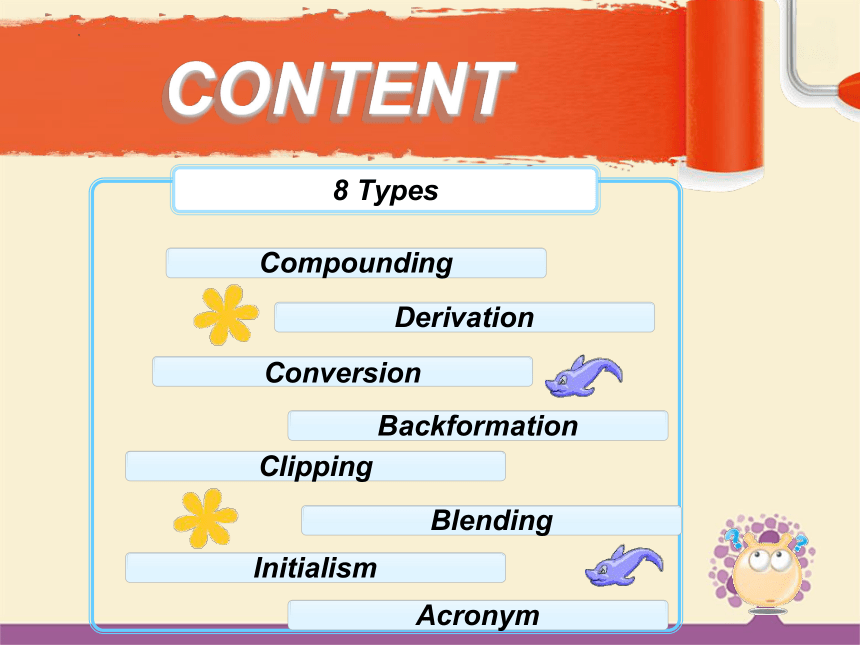

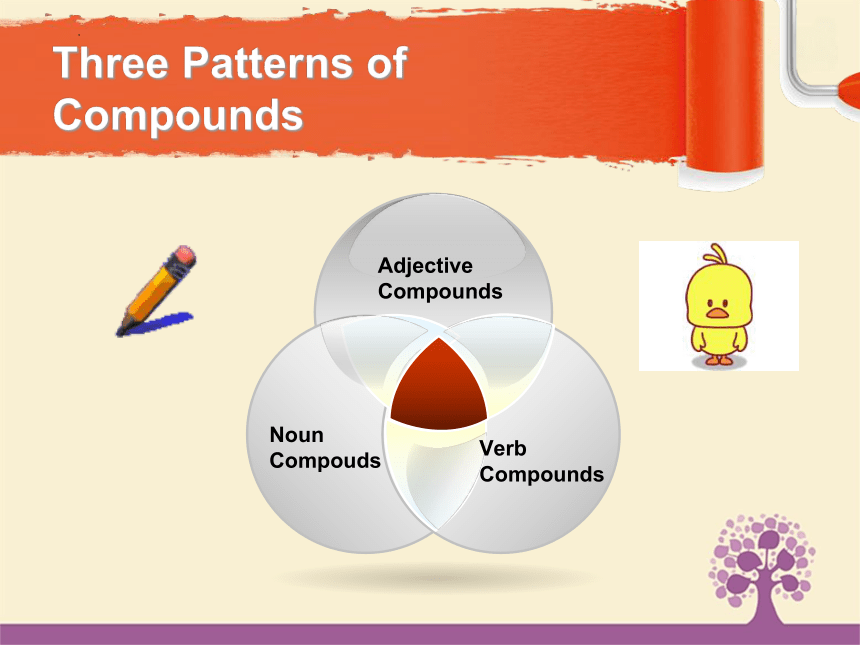
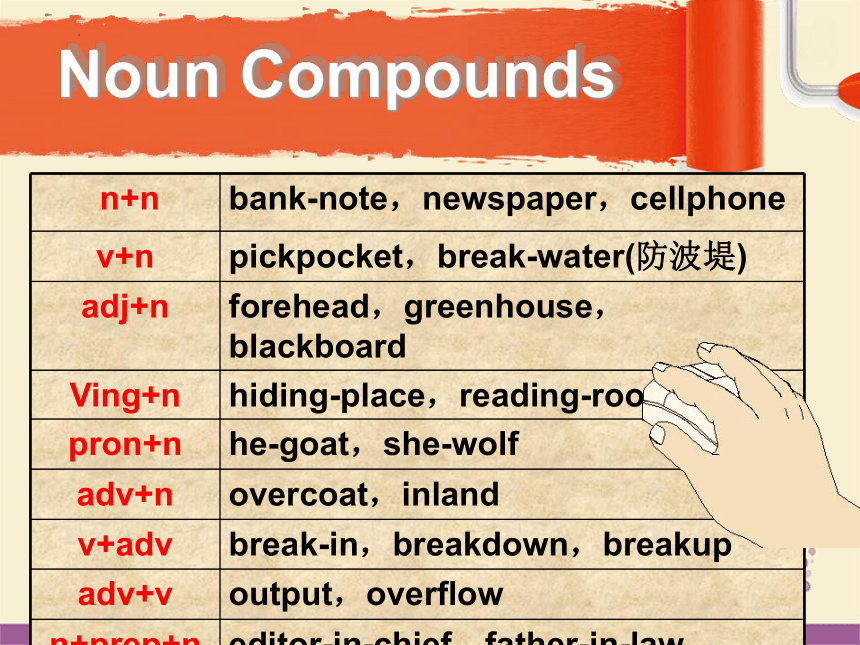

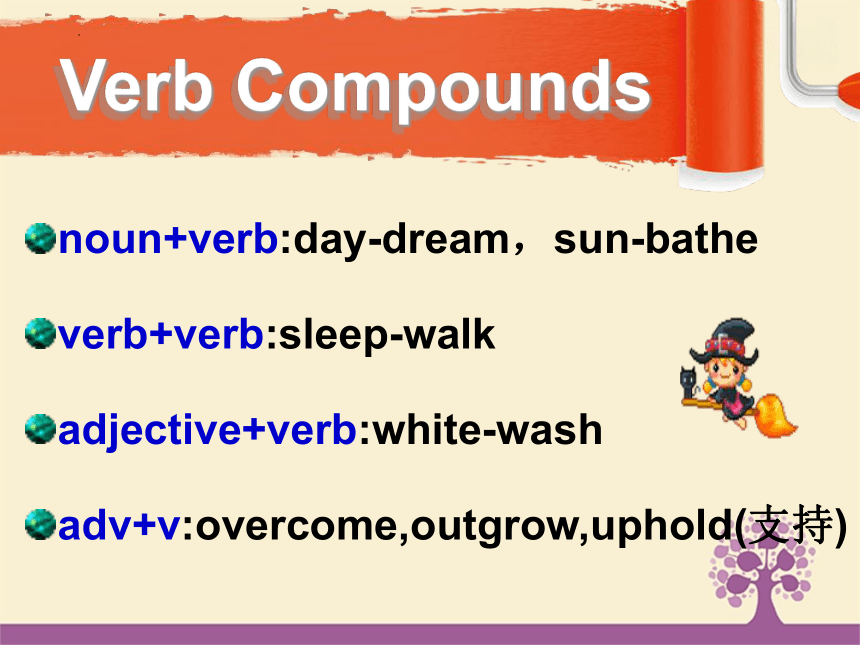
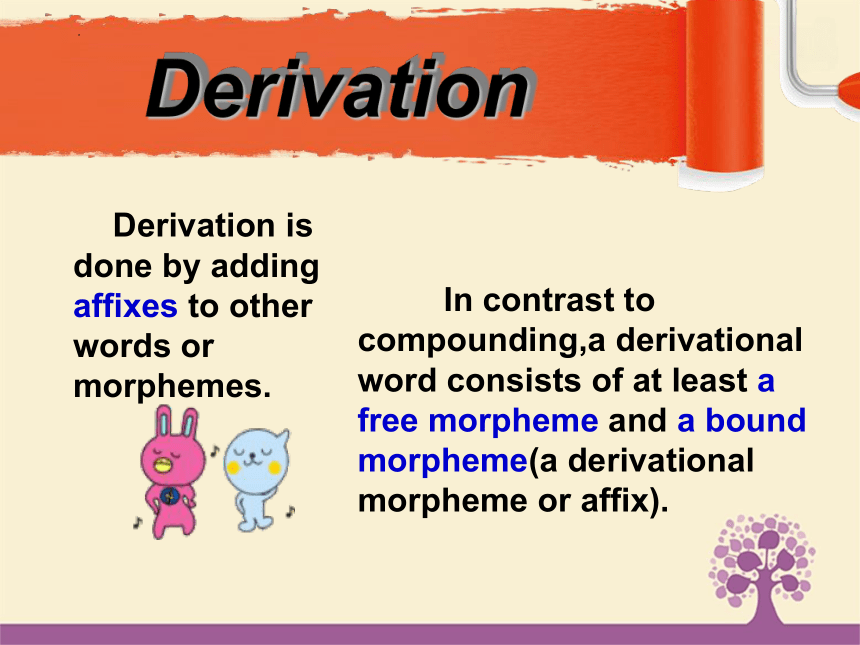
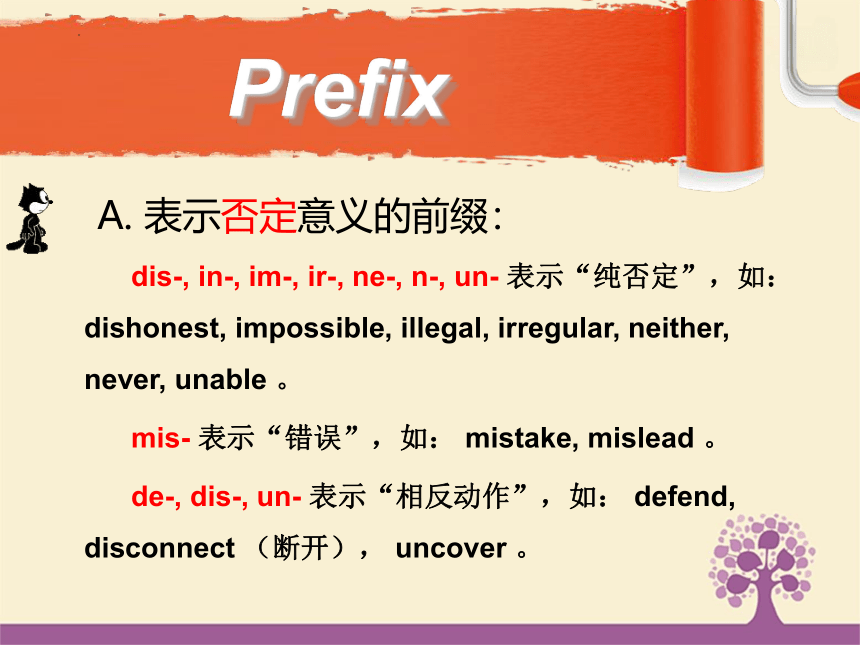
文档简介
(共27张PPT)
Types of Word Formation
----magic words
CONTENT
8 Types
Compounding
Derivation
Conversion
Backformation
Clipping
Initialism
Blending
Acronym
Compounding
Words are formed by putting two words together.
Compounds have strict patterns : the first element in the compound receives the main stress ,but it is generally the second element that determines the compound’s new word class.
Three Patterns of Compounds
Noun Compouds
Adjective Compounds
Verb Compounds
Noun Compounds
n+n bank-note,newspaper,cellphone
v+n pickpocket,break-water(防波堤)
adj+n forehead,greenhouse,blackboard
Ving+n hiding-place,reading-room
pron+n he-goat,she-wolf
adv+n overcoat,inland
v+adv break-in,breakdown,breakup
adv+v output,overflow
n+prep+n editor-in-chief,father-in-law,mother-in-law
Adjective Compounds
adj+adj:red-hot,bitter-sweet, dark-blue
adj+n:part-time, second-hand, bare-foot
n+adj:world-famous,snow-white, lifelong
v+adj:stir-crazy
adv+adj:ever-green,over-sensitive
num+n:five-year
num+n+adj:five-year-old,sic-inch-tall
num+ned:four-legged, six-storied , two-faced
Verb Compounds
noun+verb:day-dream,sun-bathe
verb+verb:sleep-walk
adjective+verb:white-wash
adv+v:overcome,outgrow,uphold(支持)
Derivation
Derivation is done by adding affixes to other words or morphemes.
In contrast to compounding,a derivational word consists of at least a free morpheme and a bound morpheme(a derivational morpheme or affix).
Prefix
A. 表示否定意义的前缀:
dis-, in-, im-, ir-, ne-, n-, un- 表示“纯否定”,如: dishonest, impossible, illegal, irregular, neither, never, unable 。
mis- 表示“错误”,如: mistake, mislead 。
de-, dis-, un- 表示“相反动作”,如: defend, disconnect (断开), uncover 。
B. 表示空间位置、方向关系的前缀:
a- 表示“在……之上,向……”,eg:aboard, aside 。
inter-表示“在……间;相互”,eg: international, interaction 。
out- 表示“在上面;在外部”,eg:outline,outside
trans- 表示“跨越”,eg: translate, transform,
under- 表示“在……下面”,eg:underline, underground, underwater 。
up- 表示“向上;向上面;在上”,eg:upward, uphold
C. 表示时间、序列关系的前缀:
fore- 表示“在前面;先前;前面”,eg: forward, forecast, foretell (预言)。
mid- 表示“中;中间”,eg: midnight, midsummer 。
re- 表示“再一次”,eg: retell, remarry 。
D. 表示比较程度差别关系的前缀:
extra- 表示“超越;额外”,eg: extraordinary 。
over- 表示“超过;太”,eg:overeat, overdress,
super-, sur- 表示“超过”,eg: supernature, superpower,
vice- 表示“副;次”,eg: vicepresident, vicechairman 。
E .表示数量关系的前缀:
kilo- 表示“千”,eg: kilometer 。
F. 表示特殊意义的前缀:
micro- 表示“微”,eg: microscope 。
G. 表示术语的前缀:
bio- 表示“生命;生物”,eg: biography ,biology 。
tele- 表示“远距离”,eg: television, telephone 。
名词后缀
具有某种职业或动作的人:
-an, -ian 表示“……地方的人;精通……的人”, eg: American, historian 。
-ant, -ent 表示“……者”,eg: merchant (商人), agent, servant, student 。
-ary 表示“从事……的人”,eg: secretary 。
-eer 表示“从事于……的人”,eg: engineer, volunteer 。
-er 表示“从事某种职业的人;某地方的人”,eg: banker, observer, Londoner, villager 。
-ese 表示“……国人,……地方的人”: Japanese, Cantonese (广东人)。
-ess 表示女性人称名词: actress, hostess,
-ist 表示“从事……研究者;信仰……主义者”: pianist, communist, dentist, artist, chemist 。
-logist 表示“……学家;研究者”: biologist, geologist 。
-or 表示“……者”: author, doctor
-yer 表示“从事……职业者”: lawyer 。
构成具有抽象含义的名词
-age 表示“状态、行为、身份及其结果、总称”,eg:courage, storage
-ance, -ence 表示“性质;状况;行为;过程;总量;程度”,eg: importance, diligence, difference 。
-dom 表示“等级,领域,状态”,eg: freedom, kingdom, wisdom.
-hood 表示“资格;身份;年纪;状态”,eg: manhood, fatherhood 。
-ice 表示“行为;性质;状态”,eg: notice, justice, service 。
-or, -our 表示“动作;性质;状态”,eg: favor, error 。
-ship 表示“情况;性质;技巧、技能及身份,职业”,eg: hardship,
-th 表示“动作;性质;过程;状态”,eg: depth, wealth, truth 。
形容词后缀
suffix meaning usage eg
-able 可/能…的 加在名词或及物动词后 valuable, horrible, eatable
-al 有... 性质的 加在名词后 natural, technical, actual
-ant, -ent ...的 加在外来动词词干上 important, pleasant, excellent
-ic, -ical ...性质的,与...有关的 加在外来词干的名词上 atomic, electric, basic
-ish 稍带...的,... 气的, ...民族的,... 语的 加在名词或形容词上 用于民族国家地名之上 feverish, childish, bookish
English, Spanish
-ive 有...倾向的/性质的 加在动词上 instructive, expensive
-ful 充满...的, 引起... 的 加在名词或少数名词上 thankful, powerful, tearful
-less 无/不...的,不能...的 加在名词或动词上 homeless, harmless, wireless
-ous 充满...的,有...特性的 加在名词上 dangerous, famous, nervous
-y 有/多... 的,想...的 加在名词上 cloudy, sunny, funny, sleepy
-ed 有...的, 有...特征的 加在名词或动词上 tired, interested, learned
-en 由...构(制)成的 加在物质名词上 wooden, earthen, woolen
-ern ...方的 加在表示方位的名词上 eastern, western, southern
-ly 有...性质的,...形状的 加在名词或形容词上 yearly, daily, orderly, lively
suffix meaning usage eg
-ate 表示:使成为,成为..., 处理, 使化合 见于外来词,由外来词根组成,不能活用 educate, translate, imitate,
calculate, operate, hesitate, concentrate, evaporate
-en 表示: 变为,使为,变为有,使有 加在形容词上,有时加在名词上,通常构成及物动词 darken, weaken, deepen, sharpen, glisten, frighten, strengthen
-fy 表示:使成为,使...化 加在名词或形容词上,构成及物动词和少数不及物动词 beautify, uglify, satisfy, terrify, electrify, purify
-ish 表示: 使..., 令... 大多是从法语输入的词, 不能构成新词 finish, accomplish, punish, furnish, publish, astonish
-ize 表示: 使成, 变成,...化 加在名词或形容词上,构成及物动词或少数不及物动词 modernize, democratize, revolutionize, realize, sympathize
动词后缀
副词后缀
suffix meaning eg
-ly 加在形容词之后 表示某种状态 cheerfully, slightly, simply, possibly, coolly, excitedly
表示某个方面 economically, technically
表示程度或范围 greatly, completely
表示时间 recently, presently
表示次序 firstly, secondly
表示方向 eastwardly, northwardly
-ward -wards 加在名词或副词后,表示“向......的” forward, backward, upward,
downward, toward, northward, afterward
A noun can become a verb easily and a verb can be used as a noun.
Conversion is also called zero derivation.
five major types
noun---verb
verb---noun
verb---adjective
adjective---verb
adjective---noun
Conversion
n-vt hand手---交给 date日期---定日期 face脸---面对 adj-vt empty空的---倒空 better较好---改善 cool凉爽---使凉 n-adj front前面---前面的 noble贵族---高贵的 key钥匙---关键的 adv-vt
down向下---击倒
back向后---后退
up向上---提高
vt-n drink喝---饮料 study学习---书房 vt-adj perfect使完美---完美的 fit适合---适合的 adj-n chief主要的---首领 first第一的---第一个 wrong错误的---错误 the+adj-n
the wounded---
受伤的人们
the blind---盲人们
the beautiful---美丽的东西
types of conversion
Backformation
Removing a suffix to get a new word.
Eg:
donation---donate
sculptor---sculpt
typewriter---typewrite
babysitter---babysit
intermission---intermit
Clipping
This process by which parts of a word have been cut off is called clipping.
Clipping occurs when a word of more than one syllable is reduced to a shorter form,often in casual speech.
保留前几个字母
INFO information
INS insurance
EXCH exchange
I owe you IOU
In stead of I/O
根据发音
R are
THO though
THRU through
保留开头和结尾个发音字母
WK week
RM room
PL people
拿掉所有元音
MKT: market
MGR: manager
MSG: message
STD: standard
RCV: receive
根据发音
R are
THO though
THRU through
Blending
A single new word can be formed by combining two separate forms.
1+1=
Typically,blending is finished by taking only the beginning of one word and joining it to the end of another word.
motel=motor+hotel
smog=smoke+fog
telecast=television+broadcast
A single new word can be formed by combining two separate forms.
Typically,blending is finished by taking only the beginning of one word and joining it to the end of another word.
Eg: motel=motor+hotel
smog=smoke+fog
telecast=television+broadcast
Acronym and Initialism
Acronym:Some new words are formed from the first letters of a series of words.They are pronounced as single words.
Initialism:Some new words are composed of the first letters of a serises of words and pronounced by saying each letter in them.
SARS
NATO
OPEC
TEFL
IQ
SOS
VCD
GDP
GNP
The end
T
H
A
N
K
S
Types of Word Formation
----magic words
CONTENT
8 Types
Compounding
Derivation
Conversion
Backformation
Clipping
Initialism
Blending
Acronym
Compounding
Words are formed by putting two words together.
Compounds have strict patterns : the first element in the compound receives the main stress ,but it is generally the second element that determines the compound’s new word class.
Three Patterns of Compounds
Noun Compouds
Adjective Compounds
Verb Compounds
Noun Compounds
n+n bank-note,newspaper,cellphone
v+n pickpocket,break-water(防波堤)
adj+n forehead,greenhouse,blackboard
Ving+n hiding-place,reading-room
pron+n he-goat,she-wolf
adv+n overcoat,inland
v+adv break-in,breakdown,breakup
adv+v output,overflow
n+prep+n editor-in-chief,father-in-law,mother-in-law
Adjective Compounds
adj+adj:red-hot,bitter-sweet, dark-blue
adj+n:part-time, second-hand, bare-foot
n+adj:world-famous,snow-white, lifelong
v+adj:stir-crazy
adv+adj:ever-green,over-sensitive
num+n:five-year
num+n+adj:five-year-old,sic-inch-tall
num+ned:four-legged, six-storied , two-faced
Verb Compounds
noun+verb:day-dream,sun-bathe
verb+verb:sleep-walk
adjective+verb:white-wash
adv+v:overcome,outgrow,uphold(支持)
Derivation
Derivation is done by adding affixes to other words or morphemes.
In contrast to compounding,a derivational word consists of at least a free morpheme and a bound morpheme(a derivational morpheme or affix).
Prefix
A. 表示否定意义的前缀:
dis-, in-, im-, ir-, ne-, n-, un- 表示“纯否定”,如: dishonest, impossible, illegal, irregular, neither, never, unable 。
mis- 表示“错误”,如: mistake, mislead 。
de-, dis-, un- 表示“相反动作”,如: defend, disconnect (断开), uncover 。
B. 表示空间位置、方向关系的前缀:
a- 表示“在……之上,向……”,eg:aboard, aside 。
inter-表示“在……间;相互”,eg: international, interaction 。
out- 表示“在上面;在外部”,eg:outline,outside
trans- 表示“跨越”,eg: translate, transform,
under- 表示“在……下面”,eg:underline, underground, underwater 。
up- 表示“向上;向上面;在上”,eg:upward, uphold
C. 表示时间、序列关系的前缀:
fore- 表示“在前面;先前;前面”,eg: forward, forecast, foretell (预言)。
mid- 表示“中;中间”,eg: midnight, midsummer 。
re- 表示“再一次”,eg: retell, remarry 。
D. 表示比较程度差别关系的前缀:
extra- 表示“超越;额外”,eg: extraordinary 。
over- 表示“超过;太”,eg:overeat, overdress,
super-, sur- 表示“超过”,eg: supernature, superpower,
vice- 表示“副;次”,eg: vicepresident, vicechairman 。
E .表示数量关系的前缀:
kilo- 表示“千”,eg: kilometer 。
F. 表示特殊意义的前缀:
micro- 表示“微”,eg: microscope 。
G. 表示术语的前缀:
bio- 表示“生命;生物”,eg: biography ,biology 。
tele- 表示“远距离”,eg: television, telephone 。
名词后缀
具有某种职业或动作的人:
-an, -ian 表示“……地方的人;精通……的人”, eg: American, historian 。
-ant, -ent 表示“……者”,eg: merchant (商人), agent, servant, student 。
-ary 表示“从事……的人”,eg: secretary 。
-eer 表示“从事于……的人”,eg: engineer, volunteer 。
-er 表示“从事某种职业的人;某地方的人”,eg: banker, observer, Londoner, villager 。
-ese 表示“……国人,……地方的人”: Japanese, Cantonese (广东人)。
-ess 表示女性人称名词: actress, hostess,
-ist 表示“从事……研究者;信仰……主义者”: pianist, communist, dentist, artist, chemist 。
-logist 表示“……学家;研究者”: biologist, geologist 。
-or 表示“……者”: author, doctor
-yer 表示“从事……职业者”: lawyer 。
构成具有抽象含义的名词
-age 表示“状态、行为、身份及其结果、总称”,eg:courage, storage
-ance, -ence 表示“性质;状况;行为;过程;总量;程度”,eg: importance, diligence, difference 。
-dom 表示“等级,领域,状态”,eg: freedom, kingdom, wisdom.
-hood 表示“资格;身份;年纪;状态”,eg: manhood, fatherhood 。
-ice 表示“行为;性质;状态”,eg: notice, justice, service 。
-or, -our 表示“动作;性质;状态”,eg: favor, error 。
-ship 表示“情况;性质;技巧、技能及身份,职业”,eg: hardship,
-th 表示“动作;性质;过程;状态”,eg: depth, wealth, truth 。
形容词后缀
suffix meaning usage eg
-able 可/能…的 加在名词或及物动词后 valuable, horrible, eatable
-al 有... 性质的 加在名词后 natural, technical, actual
-ant, -ent ...的 加在外来动词词干上 important, pleasant, excellent
-ic, -ical ...性质的,与...有关的 加在外来词干的名词上 atomic, electric, basic
-ish 稍带...的,... 气的, ...民族的,... 语的 加在名词或形容词上 用于民族国家地名之上 feverish, childish, bookish
English, Spanish
-ive 有...倾向的/性质的 加在动词上 instructive, expensive
-ful 充满...的, 引起... 的 加在名词或少数名词上 thankful, powerful, tearful
-less 无/不...的,不能...的 加在名词或动词上 homeless, harmless, wireless
-ous 充满...的,有...特性的 加在名词上 dangerous, famous, nervous
-y 有/多... 的,想...的 加在名词上 cloudy, sunny, funny, sleepy
-ed 有...的, 有...特征的 加在名词或动词上 tired, interested, learned
-en 由...构(制)成的 加在物质名词上 wooden, earthen, woolen
-ern ...方的 加在表示方位的名词上 eastern, western, southern
-ly 有...性质的,...形状的 加在名词或形容词上 yearly, daily, orderly, lively
suffix meaning usage eg
-ate 表示:使成为,成为..., 处理, 使化合 见于外来词,由外来词根组成,不能活用 educate, translate, imitate,
calculate, operate, hesitate, concentrate, evaporate
-en 表示: 变为,使为,变为有,使有 加在形容词上,有时加在名词上,通常构成及物动词 darken, weaken, deepen, sharpen, glisten, frighten, strengthen
-fy 表示:使成为,使...化 加在名词或形容词上,构成及物动词和少数不及物动词 beautify, uglify, satisfy, terrify, electrify, purify
-ish 表示: 使..., 令... 大多是从法语输入的词, 不能构成新词 finish, accomplish, punish, furnish, publish, astonish
-ize 表示: 使成, 变成,...化 加在名词或形容词上,构成及物动词或少数不及物动词 modernize, democratize, revolutionize, realize, sympathize
动词后缀
副词后缀
suffix meaning eg
-ly 加在形容词之后 表示某种状态 cheerfully, slightly, simply, possibly, coolly, excitedly
表示某个方面 economically, technically
表示程度或范围 greatly, completely
表示时间 recently, presently
表示次序 firstly, secondly
表示方向 eastwardly, northwardly
-ward -wards 加在名词或副词后,表示“向......的” forward, backward, upward,
downward, toward, northward, afterward
A noun can become a verb easily and a verb can be used as a noun.
Conversion is also called zero derivation.
five major types
noun---verb
verb---noun
verb---adjective
adjective---verb
adjective---noun
Conversion
n-vt hand手---交给 date日期---定日期 face脸---面对 adj-vt empty空的---倒空 better较好---改善 cool凉爽---使凉 n-adj front前面---前面的 noble贵族---高贵的 key钥匙---关键的 adv-vt
down向下---击倒
back向后---后退
up向上---提高
vt-n drink喝---饮料 study学习---书房 vt-adj perfect使完美---完美的 fit适合---适合的 adj-n chief主要的---首领 first第一的---第一个 wrong错误的---错误 the+adj-n
the wounded---
受伤的人们
the blind---盲人们
the beautiful---美丽的东西
types of conversion
Backformation
Removing a suffix to get a new word.
Eg:
donation---donate
sculptor---sculpt
typewriter---typewrite
babysitter---babysit
intermission---intermit
Clipping
This process by which parts of a word have been cut off is called clipping.
Clipping occurs when a word of more than one syllable is reduced to a shorter form,often in casual speech.
保留前几个字母
INFO information
INS insurance
EXCH exchange
I owe you IOU
In stead of I/O
根据发音
R are
THO though
THRU through
保留开头和结尾个发音字母
WK week
RM room
PL people
拿掉所有元音
MKT: market
MGR: manager
MSG: message
STD: standard
RCV: receive
根据发音
R are
THO though
THRU through
Blending
A single new word can be formed by combining two separate forms.
1+1=
Typically,blending is finished by taking only the beginning of one word and joining it to the end of another word.
motel=motor+hotel
smog=smoke+fog
telecast=television+broadcast
A single new word can be formed by combining two separate forms.
Typically,blending is finished by taking only the beginning of one word and joining it to the end of another word.
Eg: motel=motor+hotel
smog=smoke+fog
telecast=television+broadcast
Acronym and Initialism
Acronym:Some new words are formed from the first letters of a series of words.They are pronounced as single words.
Initialism:Some new words are composed of the first letters of a serises of words and pronounced by saying each letter in them.
SARS
NATO
OPEC
TEFL
IQ
SOS
VCD
GDP
GNP
The end
T
H
A
N
K
S
